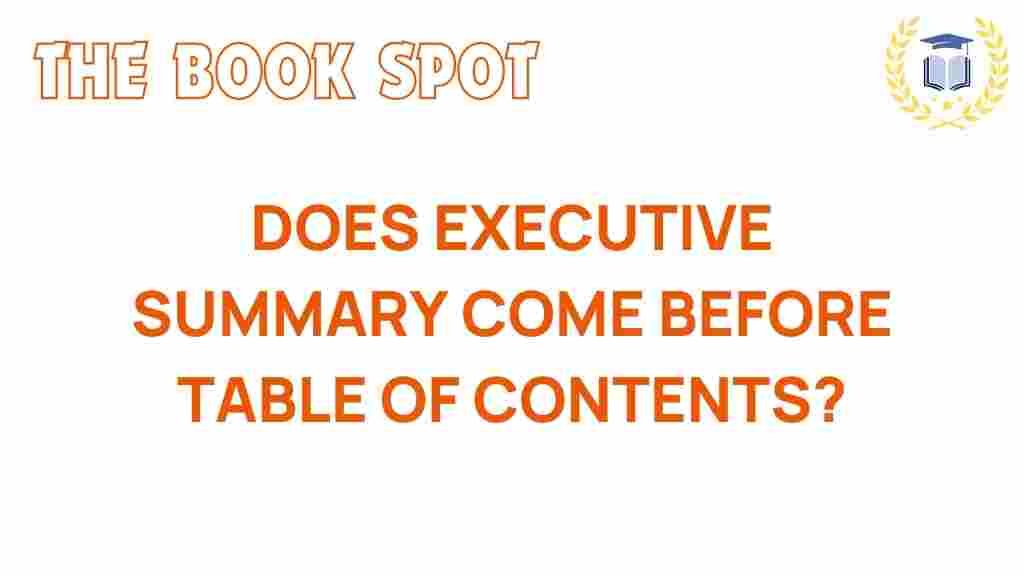The Executive Summary Dilemma: Where Should It Be Placed?
When crafting a professional report, the placement of the executive summary can greatly influence the document’s effectiveness. The executive summary serves as a crucial element that encapsulates the essence of the report, guiding readers through the main findings and recommendations. However, the question remains: where is the best place for it? In this article, we will explore the intricacies of executive summaries, the optimal report structure, and how to effectively engage your audience through thoughtful document design and content organization.
Understanding the Executive Summary
The executive summary is a brief section of a report that provides a comprehensive overview of the document’s contents. It is designed to give busy executives and stakeholders a quick understanding of the key points without requiring them to read the entire report. Here are some important aspects to consider:
- Purpose: To summarize the main findings and recommendations.
- Length: Typically, an executive summary is 10% of the total report length.
- Content: It should include the problem statement, methodology, results, and conclusions.
Optimal Placement of the Executive Summary
Determining the best placement for the executive summary in your report structure can significantly affect reader engagement. Here are the common placements and their implications:
- Before the Table of Contents: Placing the executive summary before the table of contents allows readers to quickly grasp the report’s essence before diving into the structural details.
- After the Table of Contents: This is a traditional placement that allows readers to first understand the organization of the document. It’s beneficial for those who prefer to navigate through sections before reading the summary.
- At the End of the Document: While not commonly recommended, some reports place the executive summary at the end. This can be useful for documents that require extensive background information before summarizing the findings.
Factors Influencing Placement Decisions
Several factors can influence where to place the executive summary:
- Audience: Consider who will read the report. Executives may prefer a quick overview at the start, while technical audiences might appreciate a more detailed introduction first.
- Complexity of the Content: For reports with complex data and analyses, placing the executive summary at the beginning may help clarify the findings upfront.
- Document Design: A well-designed document with clear sections can accommodate different placements of the executive summary without confusing readers.
Creating an Effective Executive Summary
Once you have decided on the placement of the executive summary, the next step is to create a compelling summary that engages the reader. Here’s a step-by-step process to crafting an effective executive summary:
Step 1: Identify Key Points
Review your report and identify the main findings, conclusions, and recommendations. This will help you distill the essential information to include in the executive summary.
Step 2: Write Clearly and Concisely
Use simple language and avoid jargon. Remember that the executive summary should be understandable to people who may not be familiar with the details of your report.
Step 3: Maintain a Logical Flow
Structure the executive summary logically. Start with the problem statement, followed by the methodology, results, and finally, conclusions and recommendations. This will help guide the reader through your thought process.
Step 4: Edit and Revise
Proofread your summary to eliminate any errors and ensure clarity. Consider having a colleague review it for feedback, as a fresh pair of eyes can catch mistakes you might overlook.
Troubleshooting Common Executive Summary Issues
Even with the best intentions, you might run into some challenges while creating your executive summary. Here are some common issues and tips on how to resolve them:
- Too Long: If your executive summary exceeds the recommended length, focus on the most critical points. Trim any unnecessary details.
- Too Vague: Ensure that your summary provides enough information for readers to understand the report’s value. Avoid generic statements and include specific findings.
- Lack of Engagement: Use engaging language and highlight the significance of your findings. Incorporating a call-to-action can also increase reader interest.
Enhancing Reader Engagement Through Document Design
A well-organized report not only conveys information effectively but also engages the reader. Consider the following document design strategies:
- Consistent Formatting: Use consistent fonts, colors, and headings throughout your report to create a professional appearance.
- Visual Aids: Incorporate charts, graphs, and images to illustrate key points and make complex data more digestible.
- Clear Table of Contents: A well-structured table of contents helps readers navigate your document easily, enhancing their overall experience.
Examples of Executive Summary Placement
Here are a few scenarios showcasing how placement can vary based on document type:
- Business Proposals: Often include the executive summary at the beginning to capture the client’s interest immediately.
- Research Reports: Typically place the executive summary after the table of contents, as readers may want to understand the report structure first.
- Annual Reports: Frequently feature the executive summary as the opening section to provide a snapshot of the year’s performance.
Conclusion
In conclusion, the placement of the executive summary is a significant aspect of report structure that can affect reader engagement and understanding. Whether you choose to place it before or after the table of contents, the key is to ensure that it is clear, concise, and compelling. By following the steps outlined in this article and considering the needs of your audience, you can create an effective executive summary that enhances the value of your professional reports.
For more insights on business writing and content organization, check out our comprehensive guide on report writing. Additionally, for best practices in document design, visit this resource for expert tips.
This article is in the category Guides and created by TheBookSpot Team

1 thought on “The Executive Summary Dilemma: Where Should It Be Placed?”